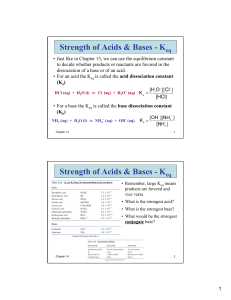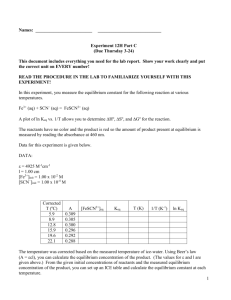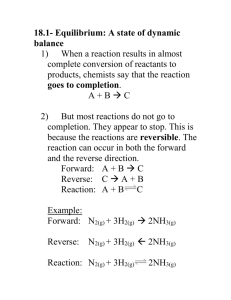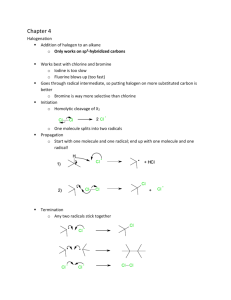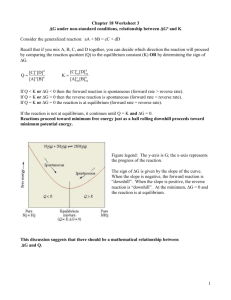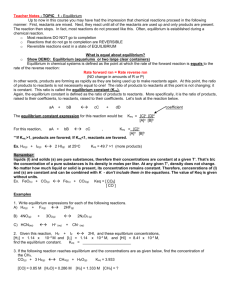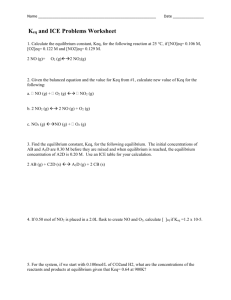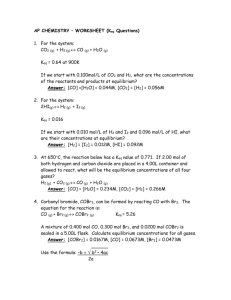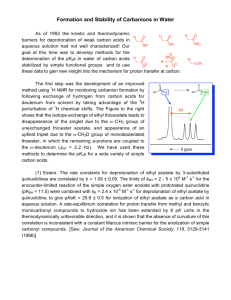More about pKa's and acid
advertisement
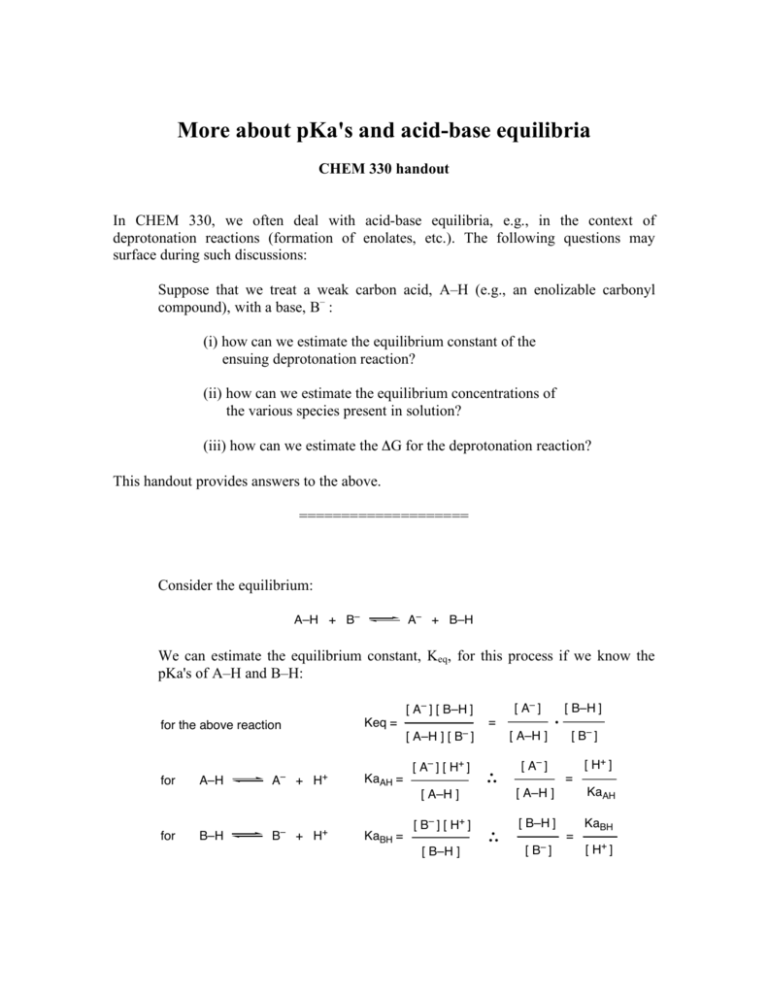
More about pKa's and acid-base equilibria
CHEM 330 handout
In CHEM 330, we often deal with acid-base equilibria, e.g., in the context of
deprotonation reactions (formation of enolates, etc.). The following questions may
surface during such discussions:
Suppose that we treat a weak carbon acid, A–H (e.g., an enolizable carbonyl
compound), with a base, B– :
(i) how can we estimate the equilibrium constant of the
ensuing deprotonation reaction?
(ii) how can we estimate the equilibrium concentrations of
the various species present in solution?
(iii) how can we estimate the ΔG for the deprotonation reaction?
This handout provides answers to the above.
====================
Consider the equilibrium:
A–H + B–
A– + B–H
We can estimate the equilibrium constant, Keq, for this process if we know the
pKa's of A–H and B–H:
[ A– ]
[ A– ] [ B–H ]
Keq =
for the above reaction
for
A–H
A–
+
H+
KaAH =
=
[ A–H ] [ B– ]
[ A– ] [ H+ ]
[ A–H ]
•
••
[ A–H ]
for
B–H
B– + H+
KaBH =
[ B – ] [ H+ ]
[ B–H ]
[ B–H ]
•
•
••
[ B– ]
[ H+ ]
[ A– ]
=
KaAH
[ A–H ]
[ B–H ]
=
[ B– ]
KaBH
[ H+ ]
CHEM 330
p2
more about pKa's
Substitution gives:
KaAH
Keq =
[ H+ ]
•
• • pKeq = p
•
[ H+ ]
=
KaBH
KaAH
KaBH
KaAH
KaBH
= pKaAH – pKaBH
Example:
Suppose that one treats ethyl acetate ("EtOAc"), pKa ≈ 25, with
NaOEt, pKa EtOH ≈ 18. Deprotonation will be incomplete because
EtO— is a weaker base than the enolate of EtOAc. For simplicity,
suppose also that the initial concentrations of the two reactants are
identical and equal to 1 M. The equilibrium constant for the
process is roughly equal to:
ΔpKa = 25-18 = 7 = p{equilibrium constant, Keq}, so, Keq ≈ 10—7
We can estimate the extent of deprotonation of EtOAc under
these conditions from the expression of Keq. For the process,
H-CH2-COOEt + EtO
CH2-COOEt + EtOH
we have:
[
Keq =
CH2-COOEt ] [ EtOH ]
[ H-CH2-COOEt ] [EtO
]
Because for each molecule of enolate that forms one also creates
one molecule of EtOH, the solution concentrations of enolate and
of EtOH will be essentially identical; furthermore, because the
extent of deprotonation is small, the concentrations of EtOAc and
of EtO— will not change much: they will be nearly equal to the initial
value of 1M. The above expression may then be simplified
(oversimplified?) as follows:
[
CH2-COOEt ] 2 ! Keq
;
[
CH2-COOEt ] !
Keq
= 10 –3.5 ! 3 x 10–4
CHEM 330
p3
more about pKa's
meaning that approximately 0.03 % (≈ 1 part in 3,000) of the starting
EtOAc will be present as the enolate under these conditions.
In general, the square root of Keq provides an estimate of the
extent of deprotonation. As a guideline, meaningful reaction
rates are achieved when this value is > 10—6
The Gibbs equation relates equilibrium constants to ΔG's:
!G = –n RT ln Keq
where n = number of moles, R = gas constant (=1.98•10–3 kcal/°K mol)
Because changes in pKa are associated with ΔG's, one may use ΔpKa's to estimate
whether a reaction step involving basic agents will be thermodynamically favorable or
unfavorable:
A step that produces a weaker base at the expenses of a stronger
base is thermodynamically favorable (because ΔG < 0)
A step that produces a stronger base at the expenses of a weaker
base is thermodynamically unfavorable (because ΔG > 0)
Example:
Determine whether the deprotonation of ethyl acetate with the anion of
diisopropylamine at 25°C is thermodynamically favorable or unfavorable and estimate
the ΔG associated with the reaction.
(i-Pr)2N– + H–CH2COOEt
(i-Pr)2N–H +
pKa ! 25
p Keq = 25 – 35 = – 10
–CH
2COOEt
pKa ! 35
Keq ! 1010 > > 1 ••• the reaction
is favorable
•
••
For 1 mole at 25°C (= 298 °K):
!G = –n RT ln Keq = – 1.98•10–3 • 298 • ln 1010 = – 13.6 kcal / mol
!G < 0
• the reaction
• • is favorable
